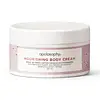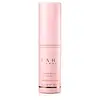What's inside
What's inside
 Key Ingredients
Key Ingredients

 Benefits
Benefits

 Concerns
Concerns

 Ingredients Side-by-side
Ingredients Side-by-side

Water
Skin ConditioningGlycerin
HumectantEthylhexyl Stearate
EmollientCanola Oil
EmollientCetearyl Alcohol
EmollientCetyl Alcohol
EmollientGlyceryl Stearate
EmollientHydrogenated Ethylhexyl Olivate
EmollientPolyglyceryl-6 Palmitate/Succinate
EmulsifyingParfum
MaskingPhenoxyethanol
PreservativeAvena Sativa Kernel Oil
Skin ConditioningPolysorbate 20
EmulsifyingCarbomer
Emulsion StabilisingHydrogenated Olive Oil Unsaponifiables
EmollientSodium PCA
HumectantEthylhexylglycerin
Skin ConditioningNiacinamide
SmoothingRubus Idaeus Seed Oil
EmollientTocopheryl Acetate
AntioxidantGlycine Soja Oil
EmollientAscorbyl Glucoside
AntioxidantLinoleic Acid
CleansingMagnesium PCA
HumectantTocopherol
AntioxidantZinc PCA
HumectantBeta-Sitosterol
Emulsion StabilisingEriophorum Spissum Flower/Stem Extract
Skin ConditioningSqualene
EmollientManganese PCA
HumectantPotassium Sorbate
PreservativeLinolenic Acid
CleansingSorbic Acid
PreservativeSodium Hydroxide
BufferingWater, Glycerin, Ethylhexyl Stearate, Canola Oil, Cetearyl Alcohol, Cetyl Alcohol, Glyceryl Stearate, Hydrogenated Ethylhexyl Olivate, Polyglyceryl-6 Palmitate/Succinate, Parfum, Phenoxyethanol, Avena Sativa Kernel Oil, Polysorbate 20, Carbomer, Hydrogenated Olive Oil Unsaponifiables, Sodium PCA, Ethylhexylglycerin, Niacinamide, Rubus Idaeus Seed Oil, Tocopheryl Acetate, Glycine Soja Oil, Ascorbyl Glucoside, Linoleic Acid, Magnesium PCA, Tocopherol, Zinc PCA, Beta-Sitosterol, Eriophorum Spissum Flower/Stem Extract, Squalene, Manganese PCA, Potassium Sorbate, Linolenic Acid, Sorbic Acid, Sodium Hydroxide
Helianthus Annuus Seed Oil
EmollientPolyglyceryl-2 Triisostearate
EmulsifyingEuphorbia Cerifera Cera
AstringentButyrospermum Parkii Butter
Skin ConditioningPrunus Amygdalus Dulcis Oil
Skin ConditioningPyrus Malus Seed Oil
EmollientOctyldodecanol
EmollientMicrocrystalline Wax
Emulsion StabilisingEclipta Prostrata Extract
Skin ConditioningMelia Azadirachta Leaf Extract
Skin ConditioningGlycyrrhiza Uralensis Extract
EmollientMoringa Oleifera Seed Oil
EmollientCandida/Garcinia Cambogia Ferment
Oryza Sativa Germ Oil
EmollientSchisandra Chinensis Fruit Extract
Skin ConditioningCurcuma Longa Root Extract
MaskingLithospermum Erythrorhizon Root Extract
Skin ConditioningCanola Oil
EmollientCaesalpinia Spinosa Fruit Extract
Skin ProtectingChlorella Vulgaris Extract
Skin ConditioningKappaphycus Alvarezii Extract
Skin ConditioningDaucus Carota Sativa Seed Oil
EmollientHydrolyzed Collagen
EmollientAlthaea Rosea Flower Extract
Skin ConditioningDaucus Carota Sativa Root Extract
Skin ConditioningTocopherol
AntioxidantAdenosine
Skin ConditioningWater
Skin ConditioningButylene Glycol
Humectant1,2-Hexanediol
Skin ConditioningBeta-Carotene
Skin ConditioningTocopheryl Acetate
AntioxidantEthylhexylglycerin
Skin ConditioningSoluble Proteoglycan
Skin ConditioningSodium Dna
Skin ConditioningBHT
AntioxidantParfum
MaskingBenzyl Salicylate
PerfumingBenzyl Benzoate
AntimicrobialButylphenyl Methylpropional
PerfumingHexyl Cinnamal
PerfumingHydroxycitronellal
PerfumingCitronellol
PerfumingAlpha-Isomethyl Ionone
PerfumingGardenia Florida Fruit Extract
Skin ConditioningHelianthus Annuus Seed Oil, Polyglyceryl-2 Triisostearate, Euphorbia Cerifera Cera, Butyrospermum Parkii Butter, Prunus Amygdalus Dulcis Oil, Pyrus Malus Seed Oil, Octyldodecanol, Microcrystalline Wax, Eclipta Prostrata Extract, Melia Azadirachta Leaf Extract, Glycyrrhiza Uralensis Extract, Moringa Oleifera Seed Oil, Candida/Garcinia Cambogia Ferment, Oryza Sativa Germ Oil, Schisandra Chinensis Fruit Extract, Curcuma Longa Root Extract, Lithospermum Erythrorhizon Root Extract, Canola Oil, Caesalpinia Spinosa Fruit Extract, Chlorella Vulgaris Extract, Kappaphycus Alvarezii Extract, Daucus Carota Sativa Seed Oil, Hydrolyzed Collagen, Althaea Rosea Flower Extract, Daucus Carota Sativa Root Extract, Tocopherol, Adenosine, Water, Butylene Glycol, 1,2-Hexanediol, Beta-Carotene, Tocopheryl Acetate, Ethylhexylglycerin, Soluble Proteoglycan, Sodium Dna, BHT, Parfum, Benzyl Salicylate, Benzyl Benzoate, Butylphenyl Methylpropional, Hexyl Cinnamal, Hydroxycitronellal, Citronellol, Alpha-Isomethyl Ionone, Gardenia Florida Fruit Extract
 Reviews
Reviews

Ingredients Explained
These ingredients are found in both products.
Ingredients higher up in an ingredient list are typically present in a larger amount.
Canola Oil is Rapeseed oil with low amounts of erucic acid. It is an emollient and helps hydrate the skin. Emollients help hydrate and soften your skin by trapping moisture.
The comedogenic rating of canola oil is 4.
Canola oil contains Vitamin E, Vitamin K, and fatty acids such as linoleic acid.
Learn more about Canola OilEthylhexylglycerin (we can't pronounce this either) is commonly used as a preservative and skin softener. It is derived from glyceryl.
You might see Ethylhexylglycerin often paired with other preservatives such as phenoxyethanol. Ethylhexylglycerin has been found to increase the effectiveness of these other preservatives.
Parfum is a catch-all term for an ingredient or more that is used to give a scent to products.
Also called "fragrance", this ingredient can be a blend of hundreds of chemicals or plant oils. This means every product with "fragrance" or "parfum" in the ingredients list is a different mixture.
For instance, Habanolide is a proprietary trade name for a specific aroma chemical. When used as a fragrance ingredient in cosmetics, most aroma chemicals fall under the broad labeling category of “FRAGRANCE” or “PARFUM” according to EU and US regulations.
The term 'parfum' or 'fragrance' is not regulated in many countries. In many cases, it is up to the brand to define this term.
For instance, many brands choose to label themselves as "fragrance-free" because they are not using synthetic fragrances. However, their products may still contain ingredients such as essential oils that are considered a fragrance by INCI standards.
One example is Calendula flower extract. Calendula is an essential oil that still imparts a scent or 'fragrance'.
Depending on the blend, the ingredients in the mixture can cause allergies and sensitivities on the skin. Some ingredients that are known EU allergens include linalool and citronellol.
Parfum can also be used to mask or cover an unpleasant scent.
The bottom line is: not all fragrances/parfum/ingredients are created equally. If you are worried about fragrances, we recommend taking a closer look at an ingredient. And of course, we always recommend speaking with a professional.
Learn more about ParfumTocopherol (also known as Vitamin E) is a common antioxidant used to help protect the skin from free-radicals and strengthen the skin barrier. It's also fat soluble - this means our skin is great at absorbing it.
Vitamin E also helps keep your natural skin lipids healthy. Your lipid skin barrier naturally consists of lipids, ceramides, and fatty acids. Vitamin E offers extra protection for your skin’s lipid barrier, keeping your skin healthy and nourished.
Another benefit is a bit of UV protection. Vitamin E helps reduce the damage caused by UVB rays. (It should not replace your sunscreen). Combining it with Vitamin C can decrease sunburned cells and hyperpigmentation after UV exposure.
You might have noticed Vitamin E + C often paired together. This is because it is great at stabilizing Vitamin C. Using the two together helps increase the effectiveness of both ingredients.
There are often claims that Vitamin E can reduce/prevent scarring, but these claims haven't been confirmed by scientific research.
Learn more about TocopherolTocopheryl Acetate is AKA Vitamin E. It is an antioxidant and protects your skin from free radicals. Free radicals damage the skin by breaking down collagen.
One study found using Tocopheryl Acetate with Vitamin C decreased the number of sunburned cells.
Tocopheryl Acetate is commonly found in both skincare and dietary supplements.
Learn more about Tocopheryl AcetateWater. It's the most common cosmetic ingredient of all. You'll usually see it at the top of ingredient lists, meaning that it makes up the largest part of the product.
So why is it so popular? Water most often acts as a solvent - this means that it helps dissolve other ingredients into the formulation.
You'll also recognize water as that liquid we all need to stay alive. If you see this, drink a glass of water. Stay hydrated!
Learn more about Water